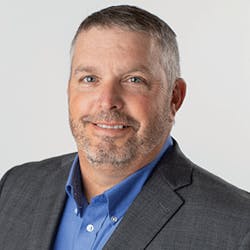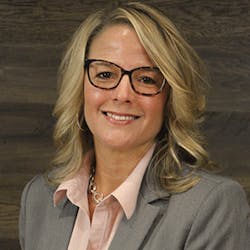ISE sent our 9 Visionaries 8 questions, asking them to select 3 to answer. Read on for insights from our 2021 ICT Visionaries from AT&T, Clearfield, CTC, Horizon, Lumen, Telia Carrier, TELUS, Verizon, and Viavi Solutions.
Topic: Proactive Network Management
ICT industry analysts and observers often focus on service providers’ CapEx budgets. But the reality is that OpEx can make or break a providers’ bottom line. The key to controlling OpEx is to improve network life cycle management for complex fiber, 5G and legacy networks in a cost-efficient manner. What are some proactive approaches you recommend to help control OpEx?
Topic: Conflict
How do you go about resolving conflict amongst team members?
Topic: Changes in Customer Experience
In terms of customer experience, it used to be about The Last Mile. Given the current landscape, many say forget The Last Mile — it’s all about the last few feet (or even inches) of the customer experience. Share your thoughts about this.
Topic: Small Business Challenges
Small businesses have been hit hard by the COVID-19 crisis. McKinsey & Company tells how small businesses face structural challenges that existed before the pandemic and have now intensified:
- Already-slim margins are under pressure from factors such as decreased demand and the cost of health-and-safety compliance.
- Adopting new business and operating models can be difficult and expensive.
- Installing new technologies that can help small businesses to succeed requires an investment many SMBs are unable to make.
How is your company helping small businesses recover, given these challenges?
(Source: https://www.mckinsey.com/about-us/covid-response-center/leadership-mindsets/webinars/protecting-us-small-businesses-from-the-impact-of-covid-19#)
Topic: Leadership
Accenture recently shared: "For a significant proportion of workers, working from home has become living in the office. That’s having a huge effect on the reciprocal agreement between employer and employee. Previously, for instance, we could assume that our employers would cover the cost of much of what we needed, like our desk, chair, computer and Internet access. But many of us are covering these costs ourselves now that we’re working at home. And while employees still get paid, the peripheral value of being physically present in a workplace — social capital, knowledge transfer, soft skills, and hands-on experience — has been lost." How can leaders help with the challenges described above?
(Source: https://www.accenture.com/us-en/insights/interactive/fjord-trends-sweet-teams-are-made-of-this)
Topic: 5G and O-RAN
In order to deliver 5G profitably, operators need to find ways to manage the high costs of network evolution, growth and maintenance. Open RAN architectures give them new tactics to create a multi-vendor interoperability ecosystem. It also encourages healthier competition, innovation, supply chain improvements, and lower costs for RAN equipment. In late 2020, the US government passed a bill to inject $750 million of funding over the next 10 years for O-RAN deployment. Share your thoughts about O-RAN and its impact on 5G’s future.
(Source: https://www.rcrwireless.com/20201118/policy/house-unanimously-passes-750-million-open-ran-5g-bill)
Topic: The She-Cession
COVID-19 created what some call a She-Cession, with record numbers of women leaving the workforce. Challenges such as pay disparities and expensive childcare have greatly increased since the COVID-19 pandemic. One particularly sobering number: according to the U.S. Bureau of Labor Statistics, there were 2.2 million fewer women in the labor force in October 2020 than there were in October 2019. What is your company doing to help reduce the number of women leaving its workforce? If you don’t have this problem, what can you recommend to help others?
(Sources: https://www.rand.org/blog/2020/11/women-are-leaving-the-labor-force-in-record-numbers.html, and https://www.bls.gov/news.release/empsit.t01.htm; https://www.bls.gov/home.htm)
Topic: Network Automation
ACG Research recently shared: "Most operators have already implemented some level of automation in their networks and operating environments. However, the level of automation currently in place is inadequate for the requirements of the market going forward. It is increasingly obvious that the market needs a much more comprehensive and pervasive level of automation in network infrastructure powered by intelligence implementation. The new level of automation must handle closed-loops as well as the capability to support full-cycle automation, enabled by A.I. This level is referred to as Autonomous Networks (AN)." Please review Figure 1 and talk about your company’s roadmap to implementing AN in 2021-2022.
Figure 1. CSPs’ Progress on Automation (Source: TM Forum 2020)
Topic: Proactive Network Management
Making the transition from CapEx to OpEx, and subsequently taking measured steps to control it can seem like a hefty task for many companies, but we believe the key is in being proactive from the outset. Some of the advice we’ve given to healthcare organizations, for example, includes early engagement with key teams so that they understand the financial flexibility and time benefits associated with a switch to OpEx. We also recommend redesigning budget models to prepare for the exclusion of depreciating IT assets and the need to spread expenses into monthly costs. When these steps are taken proactively, controlling OpEx is made much easier.
Topic: Network Automation
Over 450 petabytes of data cross our network on an average business day, and that number will continue to increase. To manage this, we need a network that is autonomous, contextual, and predictive. The network is undergoing a massive transformation from hardware to software, from proprietary to open, and from being reactive to proactive. The autonomous network is powered by data and artificial intelligence (AI), making it highly adaptable to local conditions and resilient to failure.
We’re already using AI/ML and closed loop control to automatically configure the network, repair customer impacting issues, migrate traffic to mitigate congestion, and more. We will continue on this journey, but this technology is already improving customer experiences, operational and capital efficiency. AT&T is progressing toward a more intelligent network thanks to our commitment to AI, closed-loop control, open source and SDN, and investments in 5G and edge computing.
Topic: 5G and O-RAN
For some time now, we’ve seen the strong potential O-RAN holds, including the ability to further diversify our supply chain, improve our capital and operating expenses, and spur innovation. When new ways of conducting business and developing solutions are brought to the surface, our customers benefit and that’s our main priority at AT&T — to serve the customer first in all that we do. These endless possibilities were top of mind when we became one of the first founding members of the O-RAN Alliance in 2018, and continue to be the primary driving force as we conduct field trials moving forward. Changes won’t happen overnight, but we’re excited to see the progress.
Topic: Proactive Network Management
Build it right the first time. Building an FTTH network is costly — particularly on CapEx, but Clearfield’s Labor Lite methodology supports a simplified deployment process with fewer opportunities for errors, creating a higher level of service. Labor Lite simplifies fiber maintenance, allowing providers to reduce costs, maximize resources, and turn up subscribers more quickly. From the operations perspective if an issue does arise, repairs can be made quickly with plug-and-play components. Using the high-density, scalable plug-and-play architecture of Labor Lite technology enables service providers to quickly add subscriber services by deploying additional ports as needed, and using existing
equipment, without significant additional CapEx.
Topic: Changes in Customer Experience
Recent discussions with fiber technicians reveal how concerned they are not only with their safety, but also with the well-being of their customers. However, the technician must still enter the home to unplug the fiber from the ONT (most are indoors these days) to do an OTDR trace or light level reading. Engineered to address one of the most common scenarios in FTTH deployments, Clearfield’s Home Deployment Kits complete the fiber connection from outside the home to the point where the customer equipment is located inside the home. Because homes vary greatly in size, shape, and building material, technicians previously needed different types of fasteners to attach fiber. Clearfield simplifies this by packaging all the necessary materials in one convenient kit for an improved customer experience. That’s a huge benefit to everyone involved.
Topic: 5G and O-RAN
One of the main goals of Open RAN is to foster a competitive market where not only the large traditional incumbent RAN equipment makers operate but also allow new entrants to compete for specific pieces of the RAN. Open RAN further disaggregates hardware and software components of the CU, DU, and RU elements of a 5G network as defined by 3GPP. These elements appear in fronthaul and midhaul networks. Clearfield is focused on the fiber connection in the RAN. Fiber availability will limit the impact of this disaggregation because the deployment of Open RAN cell sites will only be to areas where high-capacity fiber connections exist. Fortunately, many government funded initiatives are actively subsidizing fiber deployments across the country — mainly for high-speed consumer services. However, 5G Open RAN deployments expected to commence after 2022 will benefit significantly from these efforts.
For more information, please email [email protected]. Follow Kevin on Twitter @kevinmorgan520 and LinkedIn @kevinmorgan1.
Topic: Proactive Network Management
We have some outstanding partners that make a BIG difference in helping control our operating expenses — as well as their own. The partnerships we created with electric companies and other telecoms — to provide wholesale bandwidth and voice services — is a win-win for all entities. Along with wholesale services, we share other resources that bring substantial cost savings to all parties involved. Examples include customer relations, marketing, technical support/help desk services, engineering, and network operations.
Topic: Changes in Customer Experience
Member experience is a focal point for us over the past three years. Our team worked with a consultant on a "journey mapping" exercise where we explored the entire customer experience: from signing up for services, to calling for support, and even in-person interactions. Employees identified areas where the company thrived and areas that were pain points — internally and externally. This spurred the development of the CTC Member Experience Team. The team is tasked with helping alleviate challenges for members, improving internal processes, and being proactive with employee communication tools. That team has formed different sub-groups that focus on communication, product, process, and updated trainings. Over the last year, our focus has revolved around the user experience. We now provide best-in-class Wi-Fi solutions to both business and residential members, and are purposeful about putting control of the experience in our members hands.
Topic: Small Business Challenges
As a provider of essential services, we started by analyzing what it would take to stay operational — with minimal disruption to our members. We quickly determined which employees could work remotely and which employees needed to stay in the offices. Input was requested from each manager and their employees, including necessary equipment and supplies in order for ~80% of our employees to work remotely. This plan was then communicated to all employees and adjustments were made on a near-daily basis. By involving the employee in the plan and asking for input, it created a smoother transition for everyone. Consistent communication was key to ensuring that employee morale and mental health were being addressed. By giving employees some work-life flexibility, being proactive with announcing changes, incorporating weekly all-staff meetings and communication tools (like Slack), and encouraging employee health — both physically and mentally — the transition is positive, and peripheral value maintained.
Topic: Changes in Customer Experience
I once read that someone said A bad dessert can ruin the meal. It is so true, and using that as an analogy, it works in our industry too. It doesn’t matter how smooth and fast we are out of the gate, the closer we get to the customer premises, the more complex, integral, and personal, our offerings become, and the more important it is that we leave a positive lasting impression. Customers are now more than ever reliant on the high-speed connections fiber brings. And given more choices, they have higher expectations from those of us they choose. We must use technology and automation to optimize processes, to proactively manage complex orders, projects, and tasks. In those last few feet of the delivery timeline, proactive communication and partnership-level coordination is key. Customers need frequent updates and real-time visibility into processes so they can plan. They need the comfort and security that comes from knowing services will be there on time, work as needed, and that a 24/7 NOC is standing by to assist if they have trouble.
Topic: Leadership
This is a tough one. As leaders we have a responsibility to do whatever we can to maintain a sense of normalcy and strong corporate culture in spite of our new normal. In an effort to replace the watercooler banter, we created a group text within the team in which we harass each other with the latest sports memes, share jokes, and even vent frustration at the end of a long day. Quick impromptu Zoom meetings to discuss hot topics replace popping in each other’s offices for that quick knowledge transfer. Virtual Happy Hours and a Christmas party with games, drinks, and ugly sweaters, provide much needed camaraderie. Technology is, and continues to be, the key to facilitating flexibility and connectedness while ensuring productivity in this new environment.
Topic: The She-Cession
The first step to reducing the number of women leaving the workforce is to value them. Companies must ensure that senior leaders respect and appreciate women and their contributions to their organizations. Changes brought on by COVID-19 necessitate flexibility in corporate policies to help accommodate, and even assist, valued employees to meet childcare and educational challenges through flexible in-office schedules and work-from-home options. Technology has made it possible to work from almost anywhere at any time, enabling companies to facilitate a work-life balance that was once atypical to a normal corporate culture — and this is key to slowing the she-cession.
Follow Tammy on LinkedIn @tammy-perry-b9a62a8.
Topic: Leadership
It’s very much true that the work-from-home shift, necessitated by COVID-19, has created unique challenges for our leaders and employees. It requires a significant amount of time communicating with your teams and taking the time to listen to each unique situation. When it comes to addressing the increased burden placed on our employees, its critical to listen to their concerns and to help them work through the pros and cons of that situation. If there are special circumstances that necessitate action, take that action quickly — but be balanced and fair. It’s also important to organize social get-togethers online to break up the often-monotonous routine that can characterize work-from-home settings.
Topic: Network Automation
Lumen has fully embraced the strategy of fully automating its networks and their life cycle, and has already begun integrating Artificial Intelligence and Machine Learning to improve operational support in both a reactive and proactive (predictive analytics) manner. Any of our new network infrastructure deployments are deployed with full automation and employ many of these advanced techniques. However, the challenge with having a large-scale network infrastructure is the addressability of our brownfield network elements that may be >5 years in service. These network elements may be more limited in their ability to stream telemetry and utilize the control-plane communications that make closed-loop, autonomous networks easier to implement. That means Lumen as a whole has much work to do to enable AN across its entire asset base, but for its newly deployed base, is largely at where Level 0 depicts.
Topic: Proactive Network Management
Ownership economics are critical to a service provider in ensuring that the networks you are building can scale significantly beyond the OpEx investment required to support them. That means it’s imperative providers have a strong investment strategy in how those networks are operated as they scale. This involves razor focus in network automation, the use of AI and ML (Autonomous Networks) to perform analysis and actions that were traditionally human driven. But more importantly, it requires an investment in your employees to transition traditional support functions to roles that help build that automation and autonomous capability, as well as support any complex exceptions that cannot be addressed by automation or artificial intelligence. This doesn’t happen overnight, and takes a well thought out plan for skills transformation and training that, if executed well, benefits not only the provider but also the employee.
Topic: Proactive Network Management
The cost of power (OpEx) is one of the largest challenges operators face today. Much of this stems from legacy equipment that is complex and fragmented. Many operators run older gear simply because it still works. Why change it if it isn’t broken?
The problem is that outdated equipment was not designed with efficiency in mind. In the past, increased performance was much more important than efficiency, or cost of Watt/Mb. This is changing, and increasing demands from communication equipment, partnered with greater awareness of sustainability issues, means that operators need to take a more proactive approach.
Even if sometimes older services are up and running, and you don’t want to replace gear, investing in new power-efficient equipment and simply migrating services with limited impact could be a better option. The spent CapEx would quickly be recovered by lower OpEx and increased efficiency.
Topic: Network Automation
When it comes to network automation, sometimes it can be better to interrupt everything and start all over again. Fixing and improving small things in legacy systems will not be sustainable. Arguments for a complete re-build are not that crazy if you look at the big picture. To stay competitive, increased levels of automation are paramount.
For some time now, Telia Carrier has been using automation to improve customer service and identify network events before they manifest themselves. We have already prioritized smarter network automation, and will continue to do so, from automatic configuration, provisioning, assurance, and orchestration of services, to AI-powered, zero-touch deployment of networks.
Topic: Conflict
Well over a year into the COVID-19 pandemic, people are weary of "yet another year in lockdown" or are simply a bit grumpier at work. The frustrations of the lockdown, coupled with communication challenges of not interacting face-to-face, can lead to more conflicts. Managers need to be more aware and sensitive to what teams are dealing with, both personally and professionally; small conflicts that go untreated can fester into bigger issues. Being aware of how to deal with conflict and be responsive, while taking a collaborative approach, can help organizations avoid issues from snowballing. It also helps to have a culture that promotes ownership for everyone in the organization to act before conflicts arise.
Follow Mattias on Twitter @MFridstrom.
Global SolutionsTELUS
Topic: Proactive Network Management
OpEx can be controlled by designing systems and processes with consistency, as opposed to siloing different network technologies. It can be streamlined by enabling all field teams to have a common, consistent view of network assets and using every field visit as an opportunity to capture relevant information. For example, a technician completing a fiber order can capture an update to an incorrectly coded piece of network equipment which delayed job completion. Consistent systems allow this update to be visible to a future technician working on a 5G order to benefit from the previous updates and complete their job more efficiently. Reducing siloed network information enables improved efficiency, technician experience, and customer experience.
Topic: Changes in Customer Experience
At TELUS, we put our customers first by offering the very best products and services, keeping them connected on our world-class networks, and supporting them as needed. As an industry, we cannot focus on the network upstream traditional demark point. We should be accountable for the end-to-end experience of every customer. For example, a saturated Wi-Fi spectrum in a high-rise building is not an issue we can walk away from. We have chosen to invest in industry-leading mesh Wi-Fi to improve our customer experience so they can use our world-class networks to their full potential.
Topic: Leadership
Establishing healthy team dynamics, norms, and culture, are ways leaders can enable successful remote teamwork. At TELUS, we had a decade of mobile and remote work experience prior to the recent wider shift across the industry. It takes a commitment and focus across the organization to make a successful transition. We have focused on our team and our customers throughout our journey, and realized improvements in customer satisfaction and employee engagement. With that consistent focus, we have invested in the tools and technologies to enable our continued success. An engaged team is enabled to maintain a healthy work/life balance, and has opportunities to provide regular feedback to help improve processes.
Follow Vishram on LinkedIn @faisal-vishram-8b4b7b41/.
Contact him at [email protected].
Verizon
Topic: Small Business Challenges
Verizon worked with the Local Initiative Support Corporation (LISC) to support small business needs. We offered direct donations to help fund grants of up to $10,000 to businesses facing immediate financial pressures because of COVID-19. This was especially important for entrepreneurs of color, women-owned businesses, and other enterprises that don’t have access to flexible, affordable capital.
We launched Verizon’s #PayItForwardLIVE campaign. Throughout the campaign, Verizon invested in small business support through the LISC. With periodic investments, the total of the Verizon Small Business Recovery Fund grew to $7.5 million.
Beyond direct funding, we offered tools and resources to small businesses through a partnership with Hello Alice’s Business For All initiative — a platform to bring funding opportunities, tools, mentorship, and networks, to up to 100,000 small businesses owned by underrepresented groups.
Topic: Leadership
Verizon has created our Work Forward program, where we are piloting three working models: home based, hybrid, and work site based. This is our opportunity to transform how, when, and where we work. It starts with rethinking the intersection between technology, people, and place, by applying our learnings from last year to build a more engaging employee experience. We developed a suite of resources and tools which allow us to redefine the employee experience.
It’s also important to be proactive.
Leaders can help employees with this by including employees in the definition of what the new normal is, and what the processes will be when working in this new paradigm. It is important to stay close to the employees, hear their voices, and understand the unique challenges of employees. Often that means taking the conscious effort to have regular communication between team members, create processes to enable collaboration and interaction between teams, and remembering the social aspects of the workplace — which means having virtual catch-ups that aren’t focused on work but rather on how everyone is doing personally.
Topic: Conflict
I aim to create diverse teams. Diversity in thought can inevitably lead to some conflict; however I maintain an open environment where team members are able to respectfully dissent and offer their opinions without retribution. I am a firm believer that you give the team members an opportunity to address the conflict between themselves before getting involved. This can help further collaboration and respect amongst the team members.
Having said that, it is extremely important to listen closely and step in when needed. As I make the effort to get to know each individual team member, I am able to know more quickly if there is unresolved conflict and then work with them to address it, if need be.
Follow Shari on LinkedIn @shari-g-1854413.
Topic: 5G and O-RAN
Traditionally, RAN components were built on proprietary hardware using vendor-specific communication protocols. With the scale and flexibility demanded by 5G, the proprietary black box approach is not practical. Intelligence and automation must be integrated into all aspects of the network life cycle.
Consequently, a supply chain ecosystem capable of fostering an environment for existing and new vendors is essential — one that drives innovation and healthier competition while lowering costs for RAN equipment. The ecosystem also enables automation, which can deliver scale and agility, where network components implemented as software functions can be scaled to meet network capability and capacity demands.
Topic: Network Automation
Automation is a trending buzzword. For VIAVI, not only do we look at automation of our own processes, but also our solutions for the telecom industry. We support our customers’ journey toward the Autonomous Network through test and verification, particularly as we enter an era where many providers are adopting network cloudification.
Real-time response and meeting the demands for heavy data throughput is no longer enough. With the cloudification paradigm shift well underway, elements at every network segment are transforming steadily into virtualized software functions, existing and expanding on industry standard hardware or COTS. Full Network Cloudification is next where virtualized and/or containerized network functions and elements move to the cloud, either public or private.
In this evolution, test automation is crucial, and VIAVI brings a complete solution.
Topic: Proactive Network Management
Traditionally, engineered networks stitch together segments to enable end-to-end services with predictable SLAs, whether bandwidth, latency, or scale. With today’s explosion of new verticals, on-demand applications, and massive data, the traditional approach is not feasible. Rather, the network is morphing into cloudified network segments, where the stitching is automated, on demand, real-time, and orchestrated by a layer of software systems I call the Telecom OS (Operating System).
Telecom OS is similar to our biological nervous system; it reacts to a sudden stimulus with actions to rectify, adjust, accommodate, retract. Further, data analytics and correlation in real time is like the brain connected to the nervous system: it is the decision-making and learning engine that interacts with the network segments — fiber, coax, 5G, data center — to gather data and initiate intelligent controlled actions.
At VIAVI, we help with these functions: data gathering, analytics, correlation, and AI/ML solutions.
Follow Dr. Yamany on LinkedIn @yamany.
Biographies and Company Information
Like this Article?
Subscribe to ISE magazine and start receiving your FREE monthly copy today!
Be sure your subscription is up-to-date for the next installment of this thought-leadership content:
Part 3 — October 2021
About the Author
Sharon Vollman
Content Ambassador for ISE EXPO
Sharon Vollman is the Content Ambassador for ISE EXPO. She is passionate about collaborating with thought leaders, SMEs and hard-working doers who design, plan and deploy ultra-reliable broadband networks. Vollman is committed to creating a variety of educational offerings for ISE EXPO attendees that inspire them to connect every U.S. citizen with the broadband networks we all want for our children and grandchildren.
Vollman has created educational partnerships with Broadband Service Providers including AT&T, Verizon, Lumen, Frontier Communications and others. She has covered the telecom industry since 1996.










